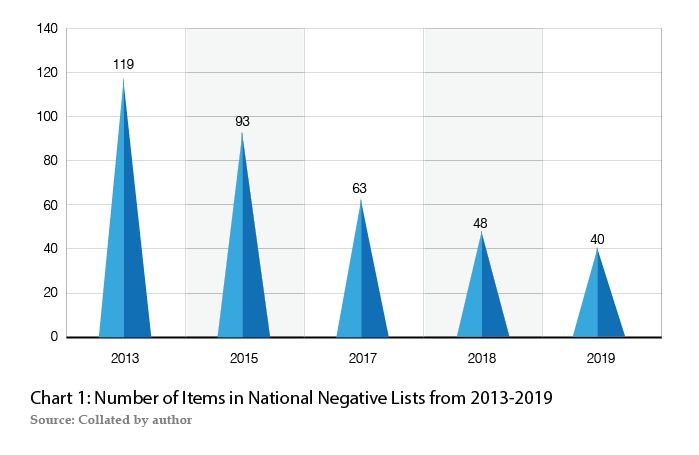Encouraged Areas for Foreign Investment
In June,China’s National Development and Reform Commission (NDRC) and the Ministry of Commerce jointly issued three documents to encourage foreign investment,reducing the scope of sectors barred to foreigners and expanding areas where investment is encouraged. The three policy documents -- the Special Administrative Measures (Negative List) for Foreign Investment Access (2019 Edition),the Special Administrative Measures (Negative List) for Foreign Investment Access to the China (Shanghai) Pilot Free Trade Zone (2019 Edition),and the Catalogue of Encouraged Industries for Foreign Investment (2019 Edition) -- all took effect on July 30,2019.
The latest Negative List – which denotes areas where foreigners cannot legally invest – has been made considerably shorter than in the past,while the Encouraged Catalogue,which covers areas where the government promotes foreign participation in the economy,has been expanded.
Improved Regulatory Framework
Prior to the 18th National Congress of the Communist Party of China in November 2012,foreign investment in China was regulated under the Catalogue of Industries for Guiding Foreign Investment. The Catalogue set out three broad categories for foreign investment: encouraged,restricted and prohibited. In the following year a new approach was adopted for the regulation of foreign investment; foreigners seeking to invest in China were given national treatment before their projects were formally considered for approval. Meanwhile,a negative list was drawn up,meaning that foreign investment was barred only in areas specifically designated as off-limits. Industries previously designated as restricted or prohibited areas were initially made part of the Special Administrative Measures (Negative List) for Foreign Investment Access in 2017. Since the creation of the negative list,the areas barred to foreigners have been gradually whittled down. “Encouraged industries” received similar treatment as in the past. This general approach has been called “pre-establishment national treatment plus a negative list.” The issuance of the latest documents has refined this overall approach,relaxing controls on market access to foreign capital and encouraging foreign investors to enter the Chinese market.
Fewer Restricted Sectors
China took measures to ease restrictions on foreign investment in 2013,2015,2017 and again in 2018. The number of items on the national Negative List (or under the restricted or prohibited categories) was reduced from 119 in 2013 to 48 in 2018,and those for free trade zones were cut from 122 to 45 over the same period. The 2019 negative list items have been reduced further to 40 nationally and 37 in the free trade zones (See Chart 1).

The latest Negative Lists further open up the agriculture,manufacturing,services and infrastructure construction sectors. In agriculture,there is no longer a provision stating that “foreign investment in the exploitation of wildlife resources originally produced in China and protected by the country shall be prohibited.” In the mining and minerals sector,the exploitation and development of oil and natural gas is no longer limited to joint ventures or cooperative projects. Additionally,the restrictions on foreign investment in the mining and processing of molybdenum,tin,and antimony have been abolished. In manufacturing,foreign investment has been allowed in the production of xuan paper and ink blocks. In services,China has lifted restrictions on domestic shipping agents,cinemas and agencies for performers. The 50% ownership limit on foreign stakes in communications,call centers and storage has also been abolished. In infrastructure construction,the construction and operation of gas and heating networks in cities with populations of over 500,000 no longer need to be controlled by Chinese interests. Moreover,in the free trade zones fishing,printing and publishing have been opened up.
More Encouraged Industries
China has learned from the experience of other nations,particularly developing countries,in making use of foreign capital. The most commonly used formula is to implement policies that promote foreign investment under the general principle of applying equal treatment to domestic and foreign investors. The 2019 Foreign Investment Encouraged Catalogue consists of two sub-catalogues — one applies to the whole country and one is applicable to the 22 provinces in China’s central and western regions.
The total of encouraged industries is 1,108. Nationwide,the number of encouraged industries has increased to 415,with 67 items added and 45 items revised,compared with the 2017 Edition. On a regional basis,the sub-catalogue of China’s 22 central and western provinces has added 54 encouraged items and revised 165 items,compared with the 2017 edition of the lists.
Foreign investment is especially welcome in advanced manufacturing and production-related services. In the field of manufacturing,the newly added or revised items cover core components for 5G communications,etchers for integrated circuits,chip packaging equipment,cloud computing equipment,industrial robots,new energy vehicles,key components for smart cars,key raw materials for cell therapy drugs,large-scale cell culture products,new aerospace materials,monocrystalline silicon,and large-size silicon wafers. In the service sector,items were added or modified in the areas of engineering consulting,accounting,taxation,inspection and certification services,cold chain logistics,e-commerce,dedicated rail lines,artificial intelligence services,cleaner production services,carbon capture services,and circular economy services.
China is also encouraging foreign investors to shift their focus to central and western parts of the country for labor-intensive industries,industries making use of advanced technology,and related equipment. At the same time,some items specific to certain provinces have been added to the encouraged list based on local advantages. For example,for Yunnan,Inner Mongolia and Hunan,there are changes affecting agricultural processing. For

